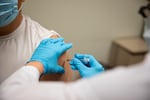About one out of every five COVID-19 infections reported in Oregon in July were breakthrough cases; those which were were diagnosed in people who are fully vaccinated, according to the Oregon Health Authority (OHA).
And 18% of Oregon’s July COVID-19 fatalities were also in fully vaccinated people. That’s a big increase from the June breakthrough report, which showed that vaccinated individuals made up just 8% of COVID-19 cases and 6% of deaths.
“While the July deaths show a higher percentage of vaccinated people have died from COVID-19 than in previous months, it’s too early to tell if this change represents a trend we will see in coming reports,” Dr. Melissa Sutton, the medical director for respiratory viral pathogens at OHA, said in a press release Monday.
Those are concerning numbers, and they highlight two key takeaways: Vaccines make a person much less likely to both contract and die from COVID-19, but at the speed the delta variant is circulating, people should take addition measures to stay safe.
COVID-19 cases are surging in Oregon and across the country, fueled by the more contagious, more severe delta variant. Oregon hospitals are quickly reaching capacity, and many counties are seeing more hospitalizations than they were in December before vaccinations were available. The delta variant appears to be two to three times more infectious than other COVID-19 variants. As Sutton put it during a Friday press conference, “for unvaccinated individuals, the risk of COVID-19 has never been greater.”
With state and local officials reluctant to pass any new mandates, Oregonians are left trying to make decisions for themselves about the sort of risks they are willing to take. But there are some lessons we can learn from Oregon’s COVID-19 data, about vaccines, masks, and the steps we can take to stay safe.

Dr. Jane Birschbach, MD, right, administers the COVID-19 vaccine to Barrett Flesh at the Deschutes County Public Health Department in Bend, Ore., Tuesday, Jan. 12, 2021.
Bradley W. Parks / OPB
It can be hard to tease lessons out of data like this. It’s collected in the real world, and the data is only as good as the system that collects it.
During Friday’s press conference, Sutton said that Oregon’s data does come with caveats. Not all cases are reported, and since breakthrough cases are more likely to be mild, they’re also less likely to be reported.
What does that mean? It means that there are probably more breakthrough cases — and more cases, period — of COVID-19 than have been reported. But it also means that the percent of breakthrough cases that result in death is not as high as it appears.
Lesson one:
According to Oregon’s data, you are six times more likely to catch COVID-19 if you are unvaccinated.
”Vaccines are saving lives in Oregon every day,” Sutton said. “[The vaccine] remains the best way to protect yourself from COVID-19.”
One caveat: it is no longer the best way to protect others. Although getting vaccinated makes you much less likely to catch COVID-19, research shows that vaccinated people who catch the delta variant can be very contagious.
Lesson two:
“The proportion of breakthrough cases is likely to increase as transmission increases,” Sutton said.
That means that the more cases of COVID-19 there are around a vaccinated person, the more likely that person is to get sick.
The more times you flip a coin, the more likely you are to have landed on heads. The more times you roll a dice, the more likely you are to have rolled a six. And, the more times you’re exposed to COVID-19, the greater the likelihood that you’ll inhale enough of the virus to get past your body’s defenses.
Or, to put it differently: even if you’re vaccinated, you should still be afraid of COVID-19 outbreaks in your community and take steps to protect yourself and others.
Lesson three:
Vaccines are less effective in the elderly, who are more likely to die from breakthrough infections. But they still reduce the risk for the elderly.
Most of the breakthrough fatalities reported in July were in elderly people, many of whom live in congregate care settings. The older a person is, the less active their immune response is. The COVID-19 vaccine is not the first to be less effective as people age, and it won’t be the last. But in a disease that previously overwhelmingly impacted elderly people, the protection provided by a vaccine can be the difference between life and death.
Lesson four:
The delta variant has changed the game, and now younger people are getting seriously ill.
There were four COVID-19 deaths reported last week. Two of the people who died were 67, one was 48, and one was 25. The 48-year-old had no underlying conditions. That’s backed up by what doctors are seeing in hospitals and the patients they treat: they’re younger than ever.
It’s too early to say for sure, but Oregon’s data suggests that the delta variant may be more likely to cause breakthrough infections and fatalities than previous variants.
Lesson five:
Vaccinated parents of unvaccinated children could bring the virus home.
One out of 5, or 20%, of July’s documented COVID-19 cases, were in vaccinated people. That means the risk of catching COVID-19 while vaccinated, though small, is not insignificant. Early data suggested the chances of transmitting the virus if you were vaccinated were very low, but more recent data from the CDC indicates that vaccinated people can be very infectious if they get sick.
Lesson six:
We should still be taking precautions to keep ourselves and others safe.
“We urge all people in Oregon to be vaccinated,” Sutton said.
But she also urged people, “to protect those who cannot, such as children under 12, by masking indoors, distancing, and avoiding large gatherings.”
So… now what?
In the month since the mask mandate was rolled back, there has been a dramatic increase in COVID-19 cases, deaths, and hospitalizations in Oregon. Some hospitals in southern Oregon are full. Others are near full.
When the state lifted the mask mandate, they tasked county and local governments with managing pandemic response. But in the absence of any mandate, it’s unclear what that means.
”I think, you know, we have been clear in recommending, for example, masking in indoor spaces, given the amount of transmission in our communities,” Sutton said. “At this point, it’s a recommendation, and we’re really leaving it to the local authority to implement it.”
She suggested that some counties are weary of more mandates and that other ways to reduce risk include working with businesses, communities, and healthcare systems.
“To be sure that there is a change in thinking and behavior,” Sutton said. “I think at this point in the pandemic, that’s really all we can do.”
The St. Charles health system in Deschutes County is entering crisis-management mode and is canceling elective surgeries.
This weekend, the Les Schwab outdoor amphitheater, also in Deschutes, is reopening for concerts. The first one is this Sunday. On the venue’s safety page, it says they follow current state guidelines, and “since Oregon hit the 70% adult vaccination threshold, we will not be requiring any of the following: Face masks, proof of vaccination, social distancing, a negative COVID test.”
Correction: This story has been updated to reflect the latest COVID-19 data from the Oregon Health Authority. It originally stated that about 1 in 10 COVID-19 fatalities in July were in vaccinated people. Updated data from OHA released Monday night shows that vaccinated individuals made up 18% of cases.



